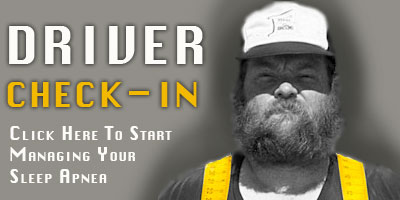Efforts under way to address condition that adds to fatigue
Safety on the road is definitely a top priority for all Transportation Risk Managers and Commercial Drivers. When searching for sources of daytime drowsiness, the sleep disorder sleep apnea was reported affect approximately 26% of the 3.4 million licensed Commercial drivers, according to a study commissioned by the Federal Motor Carrier Safety Administration. 17% of these drivers were diagnosed with mild sleep apnea, 5% with moderate sleep apnea, and 4% with severe sleep apnea.
Sleep apnea has many various symptoms including daytime fatigue due to a lack of sleep; for drivers, this could increase the risk of crashes greatly. Sleep apnea is a sleep-disordered breathing condition in which the airway to the lungs is obstructed or constricted due to the relaxation of muscles while sleeping. This causes interruptions in breathing that can last up to several seconds a time, loud snoring, and a very restless sleep. There are different types of sleep apnea, so all types of people are at-risk for this condition, however for obstructive sleep apnea (the type of sleep apnea described above), an at-risk individual has a body mass index of 30 or higher and/or a neck circumference exceeding 17 inches. Also, individuals who have other health-related problems such as obesity, diabetes, or heart problems, are also at-risk for a sleep apnea diagnosis.
One of the most dangerous aspects of sleep apnea is that most drivers affected by sleep apnea as the cause to their daytime sleepiness don’t even know they have a medical condition. Many assume that daytime drowsiness and fatigue is an average sensation during the work day. Many drivers also refuse or deny testing for sleep apnea with the fear that, if diagnosed, they will lose their jobs. Fortunately, according to Christina Culliman, Director of Workplace and Fleet Safety with the American Trucking Association, a FMCSA certified Medical Examiner is the determining factor in whether a driver can continue driving. If the examiner determines the driver is at-risk for sleep apnea, they will advise the driver to take a sleep study, and if positive, the driver would have to undergo monitored treatment for 1-4 weeks depending on the severity of the diagnosis before the examiner will re-evaluate the issue and determine whether the driver is able to safely get back on the road.
Sleep apnea has only recently gotten significant attention although it has been classified as a sleep condition in 1964. In order to educate the fleets and drivers of this potential for danger, conferences are being set up to discuss options on how to address and solve this grave safety issue.

